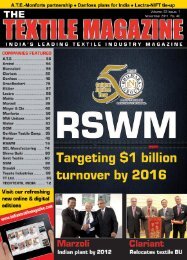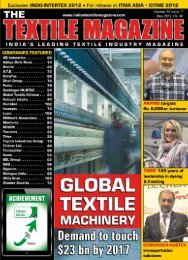policy initiatives - Textile Magazine
policy initiatives - Textile Magazine
policy initiatives - Textile Magazine
Create successful ePaper yourself
Turn your PDF publications into a flip-book with our unique Google optimized e-Paper software.
angladesh textile news<br />
Group and the Nassa Group.<br />
“The global downturn prompted many top low-cost<br />
retailers to search for more economical supply sources,”<br />
says Mr. Tagasa. “Since we operate on economy of<br />
scale and with very low profit margins, we are receiving<br />
increased orders from top retailers like Asda, Wal-Mart<br />
and Target.”<br />
The group’s spinning mills have 463,600 spindles<br />
manufacturing from 8/s to 80/s counts both in carded<br />
and combed forms, supporting both the local and export<br />
markets. In the home textiles sector, Noman is the<br />
largest producer in Asia and one of the biggest in the<br />
world, exporting to Europe and North America generally,<br />
with leading names like H&M, M&S, IKEA, Wal-<br />
Mart, Asda, Carrefour, Aldi, Lidl, and JYSK amongst<br />
its customers.<br />
In apparels, the company is greatly increasing its<br />
production capacity for twill, poplin, canvas and yarn<br />
dyed fabrics and will be launching a new product line<br />
in denim, towel and jersey knitted fabrics.<br />
The company is now expanding its woven and knit<br />
garment units, adding a new 75,000 spindle spinning<br />
mill and an additional 100,000 m 2 of fabric dyeing and<br />
finishing units. It is also investing in new poplin, bednet,<br />
terry towel and home textile facilities.<br />
Bangladesh’s more than 2,500 active garment and<br />
textile manufacturers exported $11 billion worth of<br />
knit, woven and home textile items in 2009, with only a<br />
handful exporting over $100 million or more.<br />
Cotton prices have increased significantly in the last<br />
two years, but retailers and end customers were unwilling<br />
to raise their prices. In terms of pricing, however,<br />
Bangladesh is competitive due to the low wage economy.<br />
The quality of products made in Bangladesh has<br />
also improved greatly, especially with those manufacturers<br />
who have recently invested in European technology.<br />
Noman has been able to build on these advantages<br />
by enacting new strategies such as cost minimisation<br />
in different areas of production, increasing value-added<br />
products, product diversification, segmenting the products,<br />
opening new markets, and development of new<br />
products offering better margins.<br />
A few years ago, European and North American<br />
customers thought Bangladesh was unable to turn out<br />
quality products, but now they are buying more from<br />
Bangladesh because of the price and quality of the texti<br />
les.<br />
•<br />
The <strong>Textile</strong> <strong>Magazine</strong> jANUARY 2012 | 81






